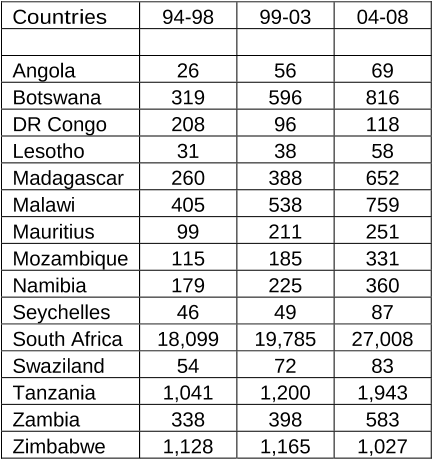




Did you find this useful? Give us your feedback











41 citations
...…are several studies that measure research output by employing bibliometric methods (Arvanitis et al. 2000; Davis 1983; Confraria and Godinho 2015; Gaillard 2000; Kahn 2011; Mêgnigbêto 2013; Pouris 2006, 2010; Pouris and Ho 2014; Pouris and Pouris 2009; Tijssen 2007; Toivanen and Ponomariov 2011)....
[...]
36 citations
36 citations
...…Pouris, from the University of Pretoria, South Africa, with 13 publications (Pouris and Richter 2000; Pouris 2003, 2010, 2011, 2012a; Lubango and Pouris 2007, 2009, 2010; Pouris and Pouris 2009; Jeenah and Pouris 2008; Inglesi-Lotz and Pouris 2013; Pouris and Ho 2014; Makhoba and Pouris 2016);…...
[...]
...…Blankley 2005; Letseka 2005; Kahn et al. 2007; Lorentzen 2009; Kahn 2006, 2013; Siyanbola et al. 2014; Ndabeni et al. 2016) and indicators (e.g. Tijssen 2007; Pouris and Pouris 2009; Pouris 2010; Mêgnigbêto 2013a, b; Confraria and Godinho 2015; Sooryamoorthy 2017; Owusu-Nimo and Boshoff 2017)....
[...]
...…2010); (7) by Louis Mitondo Lubango, from the University of Pretoria and United Nations Economic Commission for Africa, with 4 publications (Lubango and Pouris 2007, 2009, 2010; Lubango 2015); (8) by Sikiru Adigun Sanni, from Obafemi Awolowo University, Nigeria, with 4 publications (Sanni et al.…...
[...]
...Glenda Kruss is followed (1) by Anatastassios Pouris, from the University of Pretoria, South Africa, with 13 publications (Pouris and Richter 2000; Pouris 2003, 2010, 2011, 2012a; Lubango and Pouris 2007, 2009, 2010; Pouris and Pouris 2009; Jeenah and Pouris 2008; Inglesi-Lotz and Pouris 2013;…...
[...]
...…and technology in the whole continent (e.g. Tijssen 2007; Pouris and Pouris 2009; Toivanen and Ponomariov 2011, Confraria and Godinho 2015), in specific regions of the continent (Boshoff 2009, 2010; Pouris 2010; Mêgnigbêto 2013a, b, c), or in single countries (e.g. Sooryamoorthy 2009a, b)....
[...]
33 citations
...South Africa, United Kingdom, and USA12 are the most common collaborators, not only in the field of basic sciences but in general as well, and in average they constitute between 42 % in Botswana and 78 % in Malawi (Pouris 2010)....
[...]
29 citations
...Pouris (2010) dealt with the scientific production in the SADC; he made comparison among the community’s countries and found that South Africa is responsible for 79 % of the regional production....
[...]
...The results are in line with Pouris (2010)’s conclusion stating that the colonial past and cultural ties play an important role in the structure of collaborative linkages....
[...]
1,113 citations
228 citations
187 citations
...‘‘These databases currently provide the best source of information to identify the basic research activity across all countries and fields of science’’ (Tijssen 2007)....
[...]
...Examples include Shrum (1997), Narvaez-Berthelemot et al. (2002), Ingwersen and Jacobs (2004), Tijssen (2007), Pouris (1996) and others....
[...]
159 citations
119 citations